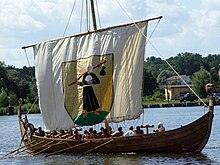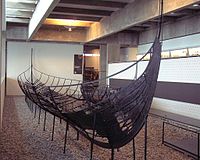Drakkar
A drakkar (also called långskip; in Spanish, "long ship") is a vessel of lashed helmet dating from the period between the years 700 and 1000. It was used by the Scandinavians and Vikings in their coastal and inland warrior raids. They were the greatest exponent of the military power of the Scandinavians, who considered them their most valuable relic. On the Lofoten Islands (Norway), some fishing boats are still manufactured using the same techniques.
Origin of the name
The word drakkar is a French transformation (Augustin Jal 1840) of a modern Swedish plural term drakar "dragons", the old Icelandic term dreki was used to designate the dragon. The vessels known as drakkar have been so called because the figurehead often consisted of the representation of the head of these fabulous beasts. These vessels were therefore called drakkar by metonymy of one of the parts that constituted them. In ancient Icelandic writings it is mentioned that pagan laws prohibited the use of these heads when going out to sea, but that, if the piece was made, it had to be removable, so that it could be removed when approaching the coast again to avoid that the landvættir (spirits protecting the land) would be intimidated.
"Dragon", in the singular, was dreki; in plural, drekar, so that drakkar is a distortion of what meant "dragons", "figureheads", or "ships".
Description

The main sources of information available on Viking navigation come from contemporary chronicles and Norse sagas: historical ones, law codices or moral texts (Íslendingabók, Landnámabók, < i>Gragás and Konungs skuggsjá); sagas (Grœnlendinga saga and Orkneyinga saga); or skaldic poetry (Hafgerðingadrápa) which together offer a rich source of details about different types of ships, names, construction, shipwrecks, appropriate seasons for sailing, seamanship, navigation techniques and climatic conditions in the North Atlantic. The problem that unites all these works is that they relate concepts from the 9th to the 11th centuries and were written around the 13th century, when The line between fiction and reality was practically non-existent.
The drakkars were long, narrow, light boats with shallow draft, with oars along almost the entire length of the hull. Later versions included a single mast with a rectangular sail that made the work of the rowers easier, especially during long voyages. In combat, the variability of the wind and the rudimentary sail made the rowers the main means of propulsion of the ship.
Almost all drakkars were built without using frames. They used the lashed hull method, overlapping wooden planks on top of each other and moss impregnated with pitch was used to cover the joints between the planks. The low weight of the drakkar and its shallow draft made it possible for it to navigate through waters only one meter deep, which made it possible to quickly disembark and even transport the boat over land.
Originally these boats did not have a keel, which was not imposed until the VII century to offer greater stability during the navegation. They also invented an ingenious rudder that was fixed to starboard.
Construction

They were made of wood, the best clues about the construction techniques of the drakkars come from the funeral ships. In Viking society it was common for kings to be cremated along with their drakkar and their most valuable possessions. The Oseberg burial ship in Norway and the Anglo-Saxon drakkar at Sutton Hoo in England are good examples.

The drakkars were extraordinarily narrow in relation to their length, especially by today's standards. The largest drakkar discovered (in the port of Roskilde) is 35 m in length, and the one found in the port of Hedeby has the largest length/width ratio: 11.4 to 1. However, vessels More recent ones, optimized for navigation, had lower ratios, often 1 to 7 or even 1 to 5.
In contrast, Scandinavian trading ships, called knarrs, had a deeper draft and were wider to accommodate cargo; To navigate they depended much more on sails. It is possible to establish a similar relationship between Mediterranean galleys and more rounded merchant ships.
Later, rectangular sails made of wool and reinforced with leather began to be used. The drakkars were very fast and fast, reaching speeds of 14 knots. They were ships with excellent navigability, but, being essentially open boats, they were not very habitable. However, this did not prevent the first Scandinavian explorers from discovering and settling in Iceland, Greenland and even reaching Newfoundland (Vinland).
Types of ships

Longships can be classified into several types based on size, construction details and prestige/category.
Snekkar (snekkja)
The snekke was the warship par excellence. A typical snekke could be about 17 m long, with a beam of 2.5 m and a draft of only 0.5 m. Her crew would consist of about 25 men.
The snekke continued to evolve after the end of the Viking Age. The later Norwegian snekkar were larger and heavier than the ships of the Viking Age.
Langskip
They were prestigious ships, as large as their keel allowed. Its dimensions were varied and it was not a very common type of boat. The Vikingeskibmuseet has a dragon boat that is 30 m long, 3.9 m wide and 0.9 m deep. She would carry between 61 and 121 men, depending on whether she used one or two for each oar.
Knarr
The knarr was the commercial version of the longship, specially built for all types of cargo including troops if necessary, livestock and thrall (slave) trading.
Famous Drakkars
- Ormen Lange
- The Ormen Lange (the Great Serpent) was the drakkar most famous of Viking King Olaf Tryggvason (Olaf I of Norway).
- Mora
- The Mora It was the ship that William the Conqueror received as a gift from his wife Matilde. It was the flagship during the conquest of England.
Gallery
Contenido relacionado
Suzaku
Cihuacoatl
Pegasus
Myth
Kamaitachi






